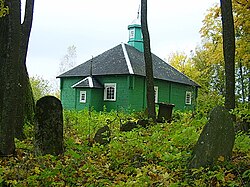Lowchytsy
Lowchytsy
Лоўчыцы (Belarusian) | |
|---|---|
Village | |
 Mosque | |
| Coordinates: 53°36′46″N 25°44′41″E / 53.61278°N 25.74472°E | |
| Country | Belarus |
| Region | Grodno Region |
| District | Novogrudok District |
| Population | |
| • Total | 16 |
| Time zone | UTC+3 (MSK[1]) |
| Area code | +375 1597 |
| License plate | 4 |
Lowchytsy (Belarusian: Лоўчыцы, romanized: Loŭčycy;[a] Russian: Ловчицы, romanized: Lovchitsy; Polish: Łowczyce)[2] is a village in Novogrudok District, Grodno Region, Belarus. As of 2009, approximately 16 people live in the village.
History[edit]
According to legend, the area was granted by King Stephen Báthory to a łowczy of Tatar origin, and named after the title.[2]
According to the 1921 census, the village had a population of 125, 96% Polish and 4% Belarusian.[3]
Islamic history[edit]
Lowchytsy was historically a site of pilgrimage for Lipka Tatar Muslims, dating back to at least 1558. Compared to Mecca and Medina, the two holiest cities in Islam, pilgrimages declined due to the anti-religious policy of the Soviet Union.[4] The original mosque, built in 1688, was rebuilt in 2002.[5]
Lowchytsy was particularly an important site for Sufism in Belarus. The tomb of wali Eŭlii Kontus, a shepherd who possessed the power to heal the sick and crippled, as well as travel to Mecca in an instant, was an important site for Sufis in the Polish–Lithuanian Commonwealth and Russian Empire.[4][6]
Notes[edit]
References[edit]
- ^ "Eternal Daylight Saving Time (DST) in Belarus". timeanddate.com. 19 September 2011. Retrieved 30 October 2014.
- ^ a b Słownik geograficzny Królestwa Polskiego i innych krajów słowiańskich, Tom V (in Polish). Warszawa. 1884. p. 752.
{{cite book}}: CS1 maint: location missing publisher (link) - ^ Skorowidz miejscowości Rzeczypospolitej Polskiej. Tom VII. Część I (in Polish). Warszawa: Główny Urząd Statystyczny. 1923. p. 58.
- ^ a b Valish, Paŭlina (20 February 2018). ""He flew like a bird to Mecca." Remembering the forgotten legend of the Belarusian Tatars". Belsat TV. Retrieved 16 February 2022.
- ^ "Ladzieniki: an unforgettable place". Tourism and recreation in Novogrudok. 17 April 2021. Retrieved 16 February 2022.
- ^ Litvin, Hienrych. Belarusian Historical Overview (in Belarusian). p. 357.

